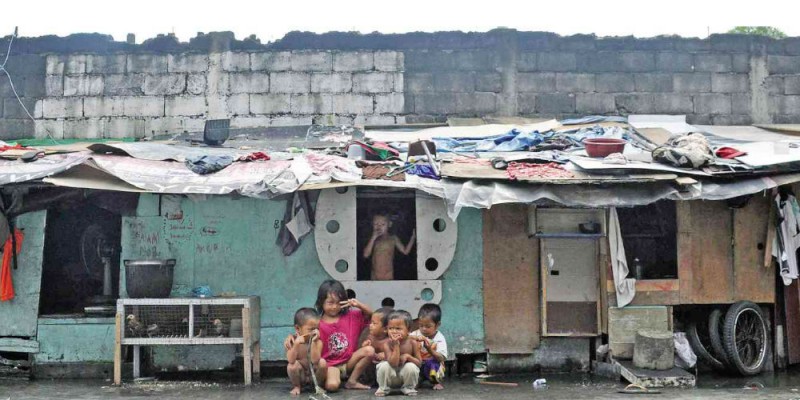
Children in front of their shanty in Manila. A Social Weather Stations survey showed the self-rated poverty average rate dropped to 44 percent in 2016. INQUIRER FILE PHOTO
The number of Filipinos who considered themselves poor fell to a record-low last year, according to a recent survey by Social Weather Stations (SWS).
While the fourth quarter survey saw a two-percentage point increase in self-rated poverty from the third quarter 2016, SWS said the self-rated poverty average rate dropped to 44 percent last year or six points lower than the 2015 average.
This surpassed the previous record low of 47 percent recorded in 1987, SWS said.
In the last quarter of 2016, 44 percent or about 10 million families considered themselves poor, two points above the 42 percent or about 9.4 million recorded in the third quarter. Self-rated poverty in Balance Luzon rose by eight points to 42 percent from September’s 34 percent, while the rate in Metro Manila dropped by five points from 36 to 31 percent.
Presidential Communications Office Secretary Martin Andanar attributed the increase in self-rated poverty in Balance Luzon to the typhoons that hit the region in the latter part of the year which, he said, “may have affected the perception of our respondents.”
“Typhoon Karen damaged thousands of hectares of agricultural lands in Ilocos, Cordillera Administrative Region, Central Luzon, CALABARZON AND Bicol. Typhoon Lawin likewise damaged houses and crops and displaced thousands in the northern part of Luzon. The Department of Agriculture has been providing assistance to those affected farmers in the wake of two destructive storms last year,” Andanar said.
“Change has indeed come, and it is being felt by our people. For two consecutive quarters, Filipino families who considered themselves mahirap/poor reached new record low,” he added.
SWS said the self-rated poverty reading “has been either steady or declining for nine consecutive quarters — from 52% in December 2014 to 51% in March… and June 2015, 50% in September… and December 2015, 46% in April 2016, 45% in June 2016, 42% in September 2016, and 44% in December 2016.”
The survey also recorded 34 percent of respondents or about 7.7 million families who considered the type of food they eat as “mahirap” or “food-poor,” four points higher than the 30 percent recorded in September 2016.
The survey, which was first published in BusinessWorld, sampled 1,500 adults nationwide and had an error margin of ±3 points for national percentages. JE/rga
RELATED STORIES
Fewer Filipino families consider themselves poor — SWS
11.4M families remain poor–SWS poll